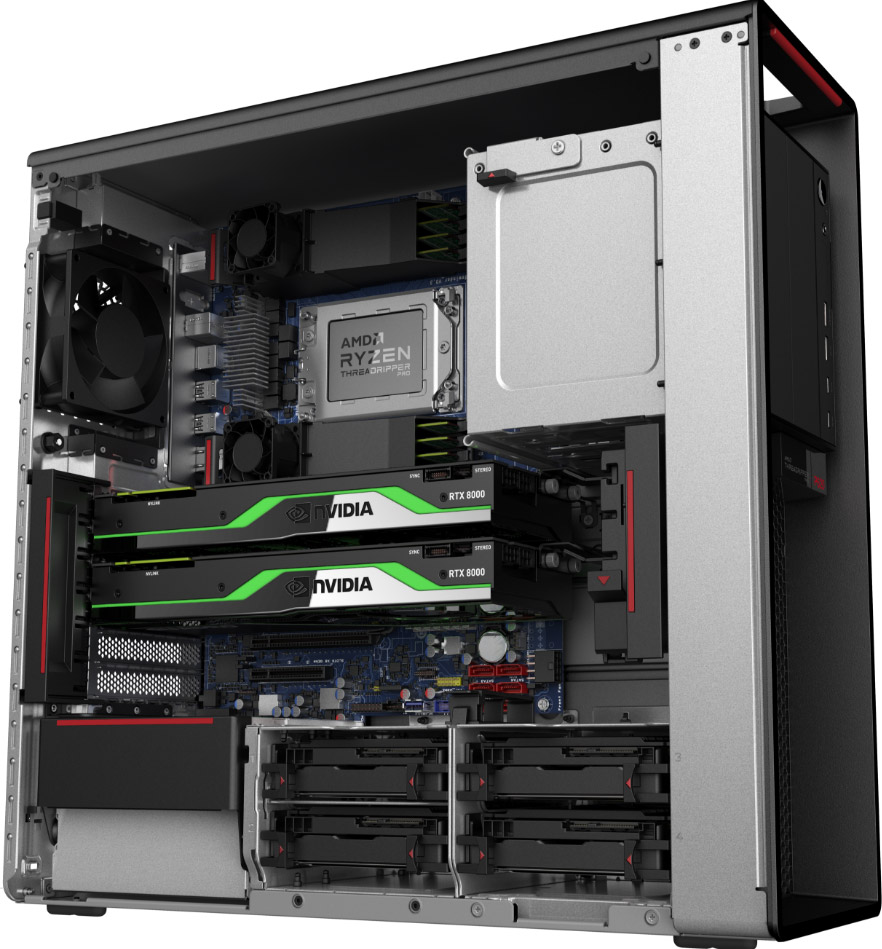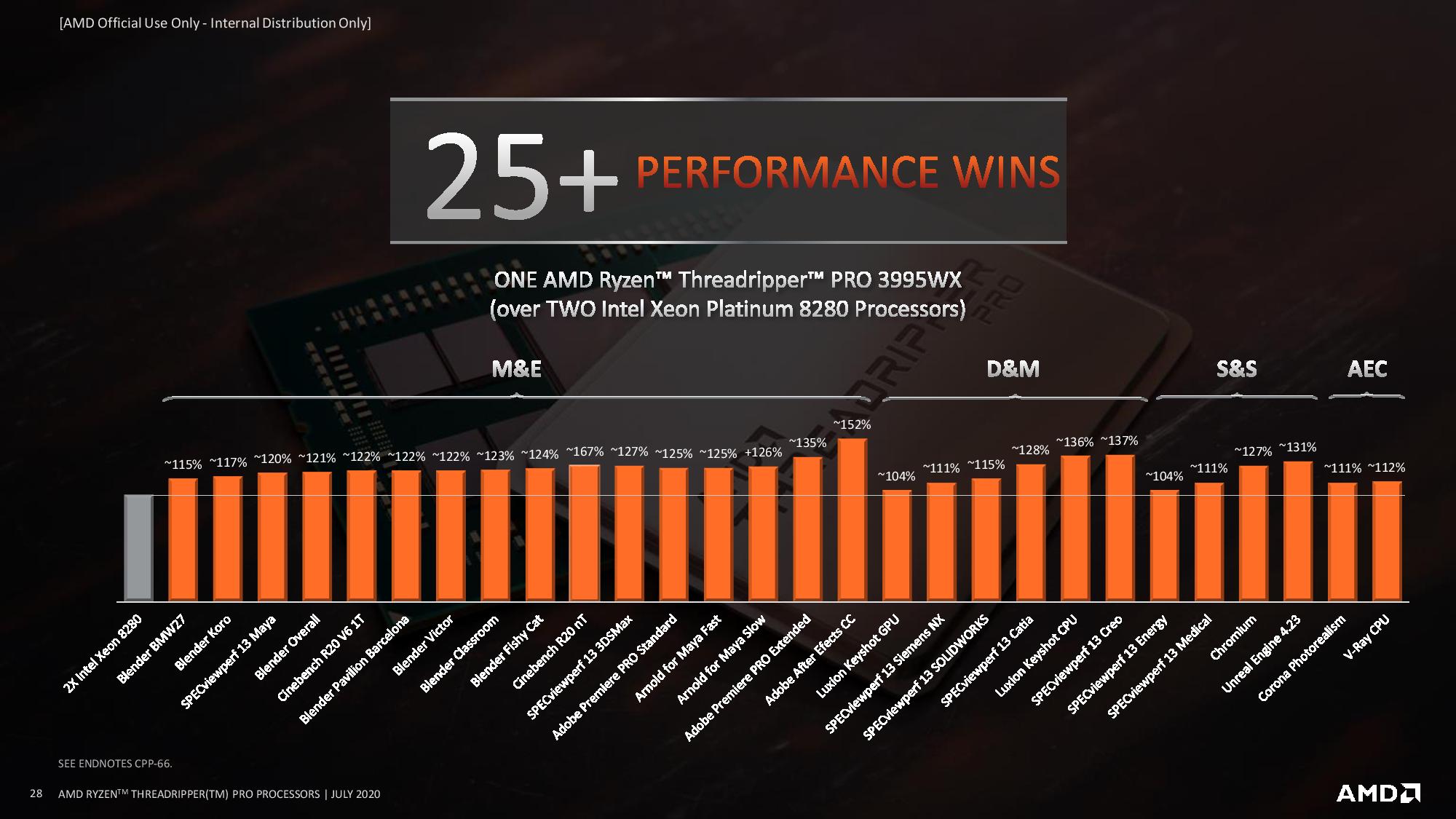
In addition to the desktop market, AMD seriously expects to take over the server market. And yesterday the company first announced a line of workstation processors under the new Ryzen Threadripper Pro brand. It should be noted, however, that these processors will only be available as off-the-shelf systems, and the corresponding consumer motherboards will not be released.
AMD's product portfolio has included Ryzen Pro and Ryzen Mobile Pro processors for generations, including ECC-enabled options. It could be assumed that while Ryzen had a Ryzen Pro variant, the most natural choice for Threadripper would be the EPYC line. The server market and the high-end desktop / workstation market have always overlapped, and up to this point, if a customer wanted a server-side design, with ECC and software validation, they turned to EPYC.
Now AMD is turning things around with the Ryzen Threadripper Pro.
Ryzen Threadripper Pro processors are similar in function to single-socket EPYCs: eight memory channels up to DDR4-3200, 128 PCIe 4.0 lanes, RDIMM and LRDIMM support, secure memory encryption support, DASH manageability support, and OS image consistency validation through AMD Pro Business Ready.
Where the Ryzen Threadripper Pro differs is in terms of core count, clocks and TDP. Judge for yourself.
| AMD Ryzen Threadripper Pro | ||||||
| Kernels | Base frequency | Turbo | Chiplets | TDP | DRAM | |
| 3995WX | 64/128 | 2700 | 4200 | 8 + 1 | 280 watts | 8 x DDR4-3200 |
| 3975WX | 32/64 | 3500 | 4200 | 4 + 1 | 280 watts | 8 x DDR4-3200 |
| 3955WX | 16/32 | 3900 | 4300 | 2 + 1 | 280 watts | 8 x DDR4-3200 |
| 3945WX | 12/24 | 4000 | 4300 | 2 + 1 | 280 watts | 8 x DDR4-3200 |
There is also a slight difference in DRAM support - TR Pro supports up to 2TB while EPYC supports 4TB. All Ryzen Threadripper Pro processors come in one socket only.
The top processor 3995WX has 64 cores. It goes beyond the top-end EPYC 7742 (225W, 2.25GHz / 3.4GHz) and even the 7H12 (280W, 2.6GHz / 3.3GHz), offering a higher base frequency of 2.7GHz and much a higher turbo frequency of 4.2 GHz for a TDP of 280 W.
Here's what a comparison of Threadripper Pro, regular Threadripper and Intel Xeon looks like:

AMD says the number of cores and frequency configurations are more optimal for different licensing needs, that is, they take into account software with core licenses (where high frequency models with fewer cores are recommended) or per socket (where more cores are recommended).
One of the interesting things about Threadripper Pro is that it is only customized for OEMs. This means that buyers will need to negotiate with Lenovo or other companies to buy equipment. Lenovo is currently looking to partner to launch the TR Pro family on the ThinkStation P620 family of workstations. The corresponding announcement has already been published on the official website.

ThinkStation P620
Lenovo will offer the P620 in a variety of flavors, with up to 1TB DRAM and two RTX 8000 GPUs (or four RTX 4000 GPUs).
The Lenovo P620 has the processor in this orientation to help with airflow, but that also limits the socket to only one DIMM per channel, so it supports a maximum of 1TB of memory. The system will use many of Lenovo ThinkStation innovations such as easily replaceable fans, drives and the like.

The task of the P620 and similar equipment is very similar to the task of EPYC - to replace top-end workstations with both one and two processors. Lenovo plans to position the P620 TR Pro to replace its P520 (single socket) and P720 (dual-socket) products. The workstation will be on sale from the end of September.
None of the other OEM workstation vendors have announced their offerings at this time, but it is possible that there will be several by the end of the year.
Technically, this system uses a WRX80 motherboard. Apparently, this motherboard will not appear on the free market, so you will not be able to assemble such a workstation yourself (not to mention the fact that the processors themselves will not appear on the market). Neither WRX80 motherboards nor processors will retail.
This is an interesting decision from AMD as the Ryzen Threadripper Pro is positioned against Intel's Xeon W-3200 and Xeon W-2200 series processors. Some of these processors are available in boxed form, while others are sold to consumers as parts, and there is a range of commercial motherboards for each. AMD's answer is simple - with their product line, they decided that there was no room for a new category of retail processors. Therefore, TR Pro and WRX80 will only be available to OEMs for now. If anyone would like to retail the TR Pro, please let AMD know.
AMD's main competitor is Intel's line of workstation processors. If you haven't been following Intel's actions, don't worry - it's a pretty big mess. Let's take it step by step:
Before Intel launched the Xeon Scalable, it offered variants of its E5-2600 line of processors as “workstation” models such as the E5-2687W v2 / v3 / v4. These sockets were compatible with high quality non-ECC Intel desktop processors or could be used in ECC validated server motherboards.
Since then, Intel has released the Skylake-based Xeon W-2100 family, offering up to 18 cores with quad-channel memory. They run on the high-performance LGA2066 desktop socket, but require dedicated server motherboards (with dedicated server chipsets). These CPUs were later upgraded to the Xeon W-2200 based on the Cascade Lake core.
At the same time, Intel had Xeon W-3100 and Xeon W-3200 processors for the LGA3647 socket, which allowed for six-channel memory and offers up to 28 cores. Intel even offered a special W-3175X model with overclocking capability.
Then in 2020, Intel added the Xeon W-1200 family to its line of workstations, using the LGA1200 consumer socket, but again with motherboards only on the server chipset. These W-1200s actually replace the E-2300 processors, and the Xeon E family has been mothballed in the Xeon W.
In addition, Intel has the Xeon Scalable Cascade Lake, which is also widely used in workstations.
AMD's argument here is that the TR Pro will compete with all Intel Xeon W offerings. Where Intel has over 80 different options for different sockets, AMD only offers four that will cover the majority of the market, plus Ryzen Pro for lower end workers. stations.
Naturally, AMD thinks they come out the winner, and just as the 64-core Threadripper 3990X was pitted against two Xeon 8280 processors, and AMD did the same with the 3995WX:

Comparison of performance in different programs (clickable): AMD will not publish official prices for their new processors, as they are only for OEMs, so it's almost impossible to compare performance on a per dollar basis here.

In addition, AMD does not give out these processors for testing to the press (which is quite natural, given the lack of motherboards on sale), suggesting asking Lenovo for the P620 workstation.
